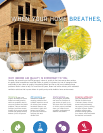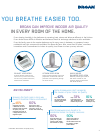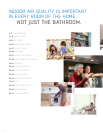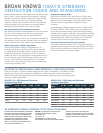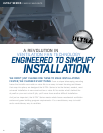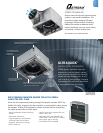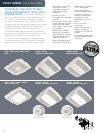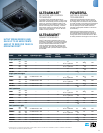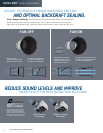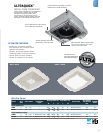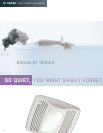
Because today’s homes are built tighter than ever before, what
gets in stays in, unless mechanically ventilated out. Premium
ventilation solutions from Broan dramatically reduce moisture
as well as airborne pollutants from off-gassing building
materials, adhesives and household cleaners. They also help
eliminate allergens, dust, pet dander and cooking effluents—
everything that contributes to poor indoor air quality.
Both spot and whole-house ventilation are important.
Spot ventilation products remove pollutants at the source when
they occur—think bathroom fans and kitchen range hoods—
quickly eliminating humidity, odor and cooking effluents.
Whole-house ventilation, also known as continuous or dwelling
unit ventilation (DUV), continually removes what’s not captured
by spot ventilation for a more healthy and comfortable home.
Understanding today’s ventilation requirements.
The American Society of Heating, Refrigeration and Air
Conditioning Engineers (ASHRAE) set the industry standard
for ventilation and acceptable indoor air quality for low-rise
residential buildings with ASHRAE 62.2. It sets the minimum
standard for spot or local ventilation of individual bathrooms of
50 Cubic Feet per Minute (CFM) delivered airflow at 3.0 sones
or less. It also specifies the requirements for whole-house
ventilation of an entire dwelling at the maximum sound rating
of 1.0 sone for ventilation fans.
Code adoption growing rapidly.
California was a leader in this area with their Title 24 Code.
Other state and city governments are quickly adopting similar
codes such as the International Energy Conservation Code
(IECC) to improve energy efficiency as well as indoor
air quality.
Above-code green building programs such as ENERGY STAR
®
for Homes, ENERGY STAR
®
Indoor Air Plus, the Leadership in
Energy and Environment Design (LEED) Certification Building
Program and the National Association of Home Builders (NAHB)
Green Building Standard are certified green building programs
that promote human health and conserve natural resources.
Let Broan help you meet the goals of these programs.
You’ve come to the right place for product solutions.
With Broan’s extensive product line-up, including exhaust and
balanced ventilation options such as Heat Recovery Ventilators
(HRVs) and Energy Recovery Ventilators (ERVs), you’re sure to
find the ideal solution to meet your needs.
BROAN KNOWS TODAY’S STRINGENT
VENTILATION CODES AND STANDARDS.
SELECTING THE PROPER WHOLE HOUSE RESIDENTIAL VENTILATION SOLUTION.
Sizing your solution is a factor of square footage and the number of bedrooms in the dwelling to meet
requirements. These charts are based on ASHRAE 62.2. Note that the 2010 and 2013 versions are
different. Most states still operate under 62.2–2010 rates. Before specifying, check local building codes
to ensure it meets requirements.
AN ALTERNATIVE FORMULA APPROACH TO THE TABLES GIVEN ABOVE.
An alternative formula approach to the tables
given above also exists and typically results
in a lower, more precise CFM requirement.
Under the more common 62.2-2010 version,
continuous CFM requirements can be
calculated using a formula as follows.
CFM = .01 x floor area (in square feet) plus
7.5 x (number of bedrooms + 1).
Example: A 3,500 square foot home with
4 bedrooms would require 73 CFM
.01 x 3,500 = 35
7.5 x (4+1) = 38
Add together for a total of 73 CFM
(as compared to the 90 from the above table).
The 62.2-2013 version increases the
multiplier for floor area from .01 to .03. Note
however that infiltration credits can be taken
if blower door testing is conducted.
ASHRAE 62.2—2010 Required Continuous
Ventilation Rate (CFM)
Floor Area
Sq. Ft.
0–1 BR 2–3 BR 4–5 BR 6–7 BR >7 BR
<1500 30 45 60 75 90
1501–3000 45 60 75 90 105
3001–4500 60 75 90 105 120
4501–6000 75 90 105 120 135
6001–7500 90 105 120 135 150
>7500 105 120 135 150 165
ASHRAE 62.2—2013 Required Continuous
Ventilation Rate (CFM)
Floor Area
Sq. Ft.
0–1 BR 2–3 BR 4–5 BR 6–7 BR >7 BR
<500 30 40 45 55 60
500–1000 45 55 60 70 75
1001–1500 60 70 70 85 90
1501–2000 75 85 90 100 105
2001–2500 90 100 105 115 120
2501–3000 105 115 120 130 135
3001–3500 120 130 135 145 150
>3501 135 145 150 160 165
8




